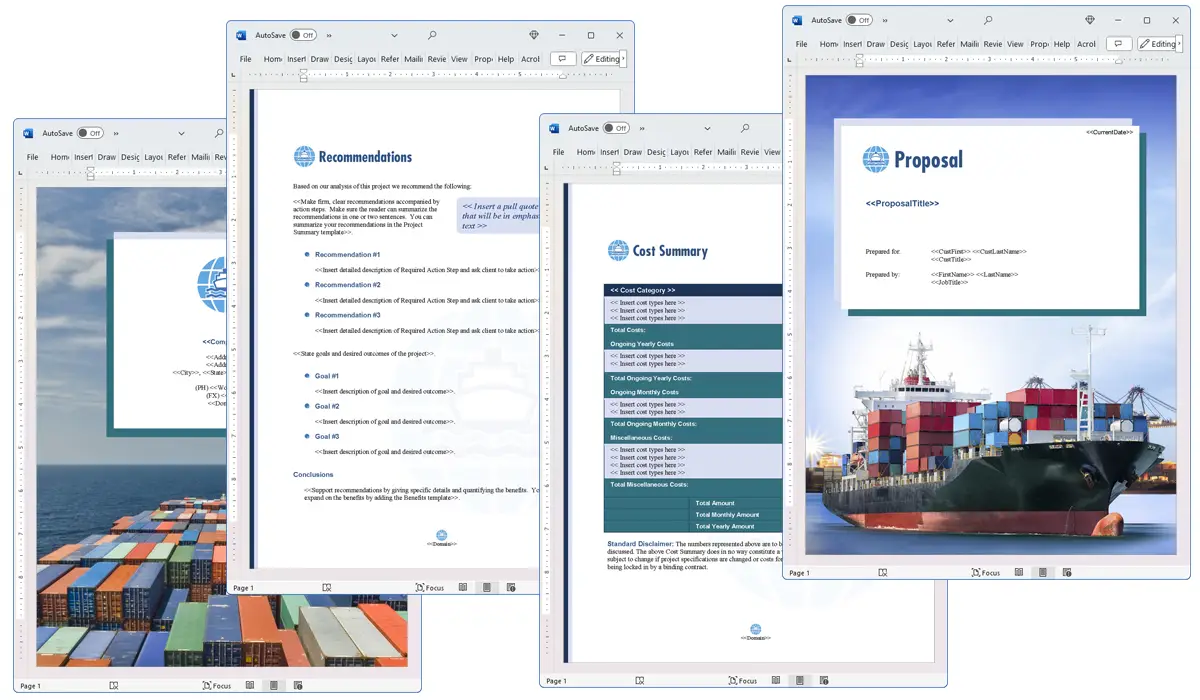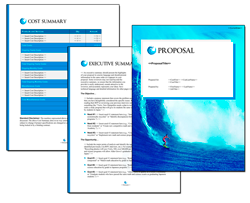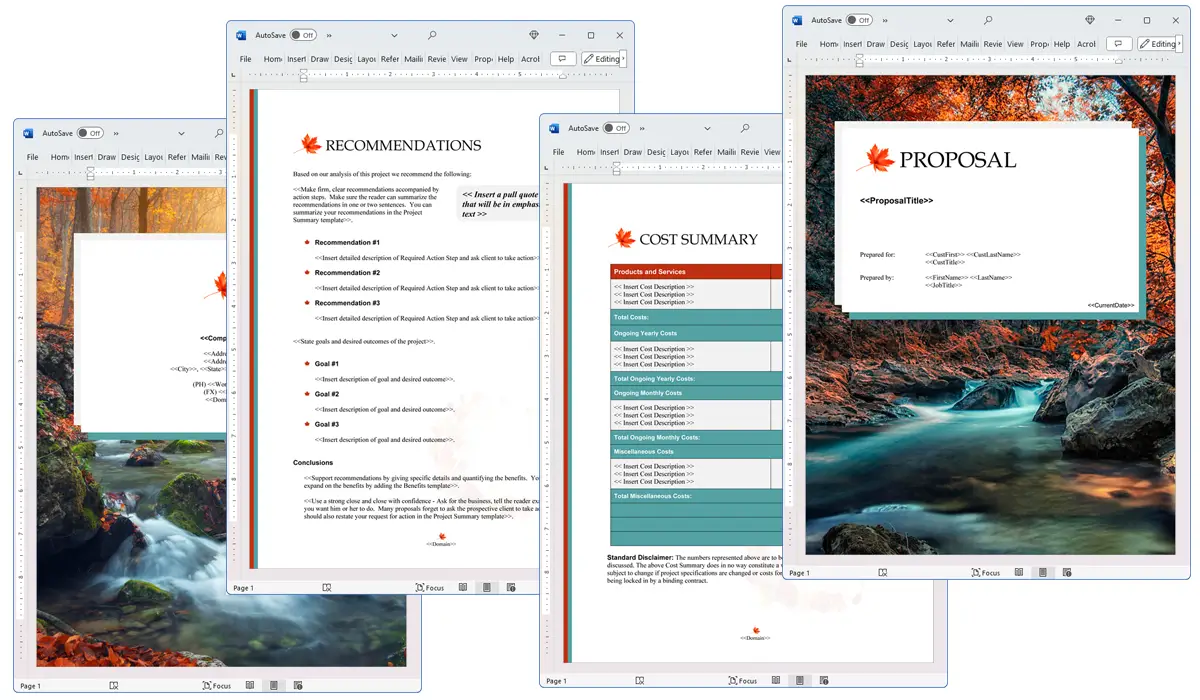What is the Ecological Impact chapter used for?
Proposal Kit Professional Bundle adds more design themes, all six Contract Packs,
a project management library, and Expert Edition software.

Illustration of Proposal Pack Transportation #7
We include this Ecological Impact chapter template in every Proposal Pack, along with thousands more. You assemble this chapter with others in various combinations to create custom-tailored business proposals, plans, reports, and other documents. Proposal Packs apply custom visual designs to the templates, giving the final documents a consistent professional finish.
 DOWNLOADABLE, ONE-TIME COST, NO SUBSCRIPTION FEES
DOWNLOADABLE, ONE-TIME COST, NO SUBSCRIPTION FEES
Overview of the Ecological Impact Chapter
The Ecological Impact chapter is an important part of a larger suite of templates offered by Proposal Kit. This chapter aids businesses and organizations in clearly demonstrating the environmental implications of their proposed projects. Given the increasing emphasis on environmental responsibility, the inclusion of this chapter in proposal documents is vital for projects that interact with natural environments or have potential ecological consequences. The content of this chapter provides a structured way to articulate how a project can affect various ecosystems and species, ensuring that stakeholders understand the ecological footprint of the project.
How is the Ecological Impact Chapter Used?
In a business proposal, the Ecological Impact chapter is used to systematically discuss the potential effects that a proposed project might have on the environment. This chapter helps businesses address ecological concerns proactively by evaluating and presenting the anticipated environmental impacts before the project commences. It serves as a foundational component for proposals that require environmental clearances or need to demonstrate compliance with environmental regulations. By including this chapter, companies can showcase their commitment to sustainable practices and their awareness of environmental stewardship.
What is Included in the Ecological Impact Chapter?
Typically, the Ecological Impact chapter includes several key elements:
- Introduction to the Project: Briefly describes the project and its objectives.
- Description of the Ecological Environment: Details the current ecological status of the area affected by the project.
- Impact Analysis: Discusses the anticipated positive or negative impacts on local flora and fauna, water resources, soil, air quality, and biodiversity.
- Mitigation Strategies: Outlines approaches to minimize negative impacts through sustainable practices, conservation efforts, and other ecological protection measures.
- Monitoring and Evaluation: Specifies how the impact on the environment will be monitored and evaluated over time.
Use Case Examples for the Ecological Impact Chapter
- Environmental Proposals: For projects needing environmental impact assessments to secure permits or funding.
- Green Initiatives: Proposals focused on renewable energy projects such as solar farms or wind turbines.
- Nature Conservation Efforts: Projects aimed at habitat restoration or endangered species protection.
- Farming and Agriculture: Proposals introducing new farming techniques that aim to reduce environmental footprints.
- Ranching: Initiatives to implement sustainable grazing practices that protect grassland ecosystems.
- Research and Science: Studies designed to explore ecological phenomena or the impacts of human activity on ecosystems.
- General Information: Educational or outreach projects aiming to raise awareness about ecological issues.
Key Takeaways
- Important for Environmental Responsibility: The Ecological Impact chapter is crucial for demonstrating a project's commitment to sustainable environmental practices.
- Comprehensive Analysis: It provides a detailed analysis of potential environmental impacts and mitigation strategies.
- Regulatory Compliance: Assists in aligning projects with environmental regulations and securing necessary approvals.
- Versatile Application: Useful across various industries including environmental, agricultural, and scientific fields.
- Stakeholder Engagement: Enhances communication with stakeholders about the ecological aspects of the project.

Illustration of Proposal Pack Aqua #8
 What Our Clients Say
What Our Clients SayTemplates are very well researched and created. The vast repository of templates and formats are great for the experienced. We have used a small set of templates and have found them to be extremely good as a framework to develop the proposal around. One of the best researched products I have seen in the market. Excellent Templates."
 4.7 stars, based on 845 reviews
4.7 stars, based on 845 reviewsRelated Chapters
Document Layouts Using the Ecological Impact Chapter

The Ecological Impact chapter and other chapters are integrated into a Word document as illustrated here in the Proposal Pack Nature #8 design theme. There are hundreds of design themes available, and every design theme includes the Ecological Impact chapter template.
A proper business proposal will include multiple chapters. This chapter is just one of many you can build into your proposal. We include the complete fill-in-the-blank template in our Proposal Pack template collections. We also include a library of sample proposals illustrating how companies in different industries, both large and small, have written proposals using our Proposal Packs. This template will show you how to write the Ecological Impact.
We include a chapter library for you to build from based on your needs. All proposals are different and have different needs and goals. Pick the chapters from our collection and organize them as needed for your proposal.
Using the Proposal Pack template library, you can create any business proposal, report, study, plan, or document.
 Ian Lauder has been helping businesses write their proposals and contracts for two decades. Ian is the owner and founder of Proposal Kit, one of the original sources of business proposal and contract software products started in 1997.
Ian Lauder has been helping businesses write their proposals and contracts for two decades. Ian is the owner and founder of Proposal Kit, one of the original sources of business proposal and contract software products started in 1997.By Ian Lauder
 Published by Proposal Kit, Inc.
Published by Proposal Kit, Inc.


 Cart
Cart
 Facebook
Facebook YouTube
YouTube X
X Search Site
Search Site